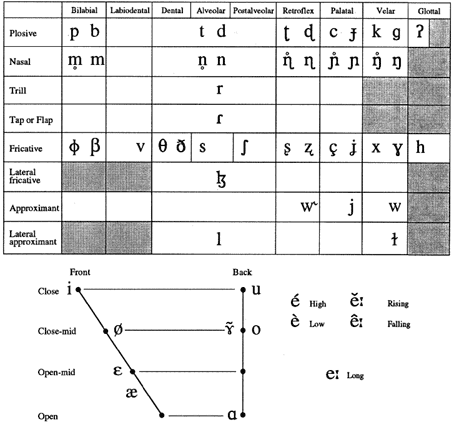The rami are not a kind of terras folk. They look like blue-gray humans with non-functional wings and floor-length tails. They are related to dragons in the same way the terras are related to humans. [Eventually there'll be more on the rami on their own page.]

(It may not be immediately visible, but the diacritic over the close-mid back unrounded vowel is a nasalization tilde.)
Intervocalically and next to voiced consonants, s and sh have the voiced allophones z and ʒ.
A Rami radix (ur-root) is generally of the form (S)C(X)T(S)C(X), where X is a non-nasal, C is any consonant, and S is any of r q qh s v sh l lz rh. The T is a pitch with no specified vowel.
Most radices are inherently adjectival in meaning. An example radix is rk-rx, "two".
A stem is formed from the radix by the addition of vowels, which is partially based on function. That is, the same radix will take different vowels depending on whether an adjectival or a verbal stem is being formed.
For example, the radix p+r, roughly "rainy", becomes the adjectival stem pi+ri-, or the verbal stem pe+ra+.
However, the same vowels are not added in every case: the adjectival stem of r-m, "rami", is ra-mi+.
Verbs are not marked for tense. They do carry an obligatory evidentiality marker, that is, a morpheme describing how the speaker perceives the reality of the event being described.
There are three markers: one for an event directly perceived (gnostic) one for an expected or hypothetical event (agnostic) and one for an event reported by someone else (hearsay).
Examples:
lze-gnga+tho+ "there are many (I know it)"
lze-gnga+kew- "there may be many"
lze-gnga+pu+ki- "there are many (so I am told)"
Nouns are normally formed from adjectives. The nominalizer used depends on the class of the adjective.
Examples:
pi+ri-qõõ~ "rain" (class II)
cnä+sce^ti+ "quartet" (class VIII)
ra-myo+ "ramyo" (class X)
Nouns are not marked for number. If necessary, a number adjective can be added:
pii+ci-ra-myo+ "one ramyo"
rhu-mbi-ra^myo+ "three ramyo"
Verbs are marked for person. The agent or subject of a verb appears before the verb. For the first person gnark+, "this" is used; for the second person sith-, "that".
Examples:
si-thö-qhö+rsha+tho- "There are few of you"
gna+rke^qe+ma+tho- "I am afraid" or "We are afraid"
rka-rhxi+ra-myo-gõõ^nda-pu+ki- "There are two ramyo walking (I hear)"
There's high and low pitch/tone/whatever. In a long vowel, rising/falling appear as combinations of L+H and H+L.
Pitch can be either inherent (directly in the vowel), inherited (directly in the root, and expressed in whatever vowel is used), or inferred (unspecified directly and dependent on the surrounding pitches).
In English a "housepet" is a pet for the house, and a "pethouse" is a house for the pet. Rami compounds run the same way.